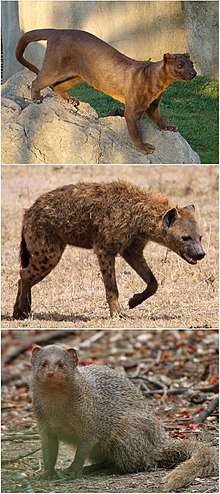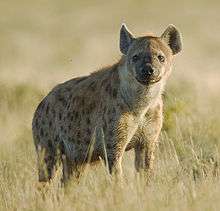Herpestoidea
Herpestoidea is a superfamily of mammalia carnivores which includes mongooses,[1] Malagasy carnivorans[2] and the hyenas.
| Herpestoidea | |
|---|---|
 | |
| Scientific classification | |
| Kingdom: | Animalia |
| Phylum: | Chordata |
| Class: | Mammalia |
| Order: | Carnivora |
| Suborder: | Feliformia |
| Infraorder: | Viverroidea |
| Superfamily: | Herpestoidea Bonaparte, 1845 |
| Families | |
|
See text | |
| Synonyms | |
|
Hyaenoidea | |
Herpestoids, with the exception of the hyenas, have a cylindrical and elongated body, which allows them to get into holes to catch prey.[1] Herpestoids are feliforms and specialize in hunting animals bigger than they are.[3]
They live throughout Eurasia, Africa and the island of Madagascar.[3]
 Hyaenidae
Hyaenidae Eupleridae (fossa)
Eupleridae (fossa) Herpestidae
Herpestidae
Classification
- Superfamily Herpestoidea
- Family Eupleridae (Malagasy carnivorans)
- Family Herpestidae (mongooses and allies)
- Family Hyaenidae (hyenas and aardwolf)
- Family †Lophocyonidae
- Family †Percrocutidae
Phylogenetic tree
The phylogenetic relationships of Herpestoidea are shown in the following cladogram:[4][5]
| Herpestoidea |
| |||||||||||||||||||||
gollark: There is that little red warning icon beside the config option.
gollark: Only for nice URLs mode and it does.
gollark: You're using nginx, The rewrite page has Documentation on Configuring it with Nginx.
gollark: https://www.dokuwiki.org/rewrite
gollark: <@!309787486278909952> https://www.dokuwiki.org/config:userewrite
References
- Wozencraft, W.C. (2005). "Order Carnivora". In Wilson, D.E.; Reeder, D.M (eds.). Mammal Species of the World: A Taxonomic and Geographic Reference (3rd ed.). Johns Hopkins University Press. pp. 562–571. ISBN 978-0-8018-8221-0. OCLC 62265494.
- Wozencraft, 2005, pp. 560–561
- S. Smith. All about Herpestoidea. p. 150–231. Retrieved 08.31.2018
- Barycka, E. (2007). "Evolution and systematics of the feliform Carnivora". Mammalian Biology. 72 (5): 257–282. doi:10.1016/j.mambio.2006.10.011.
- Morales, Jorge; Mayda, Serdar; Valenciano, Alberto; DeMiguel, Daniel; Kaya, Tanju (2019). "A new lophocyonid, Izmirictis cani gen. et sp. nov. (Carnivora: Mammalia), from the lower Miocene of Turkey". Journal of Systematic Palaeontology. Online Edition. 17 (16): 1347–1358. doi:10.1080/14772019.2018.1529000.
This article is issued from Wikipedia. The text is licensed under Creative Commons - Attribution - Sharealike. Additional terms may apply for the media files.